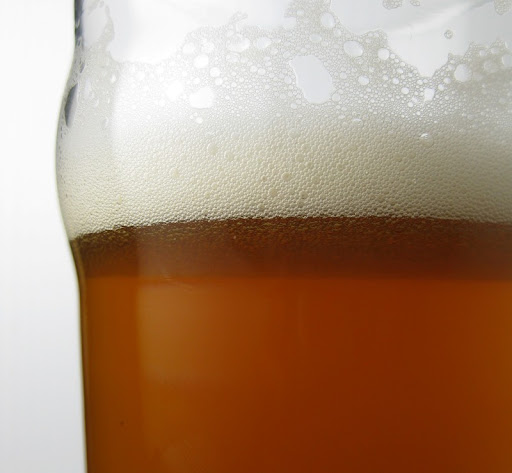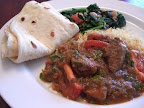Partial Mash Brewing and an IPA Recipe Modeled After Blind Pig

Given that a year and a half has now passed since we brewed our last batch of beer, it was clearly time to get the wort boiling again. This time, in our ongoing quest for our perfect IPA, we took a step forward into the world of partial mash brewing.
Partial mash is a technique that allows you to get some of the flexibility and control of all-grain brewing, while still allowing for a kitchen-friendly stove-top boil. Basically, you are moving part way from extract brewing to all-grain by replacing roughly half of your extract with grain.

We bought the malted barley whole at our local brewing supply store, and used their barley crusher to mill it into the form you see above.
The cracked barley gets mixed together with the specialty grains you are using and it all goes into a big mesh bag.

The next step is the mash. For our mash vessel, we used a 3 gallon beverage cooler - perfect for keeping hot water at a reasonably stable temperature for the hour or so the grain is steeping. This size cooler can handle up to 6 pounds of crushed grains in about 8.25 quarts of water. Since the cooler and grains start out unheated, we used 165 degree water, shooting for a target mash temperature of 150-153 degrees.

It's important to lower the bag of cracked grains into the cooler very slowly and prod it with a spoon to ensure that no dry patches of grain are trapped in the center.

Another great thing about the cooler is that the spigot provides an easy way to get the wort out after the mash is complete.

After you've collected the first wort, it needs to be immediately heated to 168 degrees to stop enzymatic activity and keep the sugars fermentable. This is done by pouring the wort into a pot that already contains a small amount of boiling water. You then bring the wort to a boil on the stove top just like you would do for all-extract brewing.

While the first wort is heating, more hot water gets added to the wet grains in the cooler and allowed to sit for another 5 minutes before draining off every drop of this second wort to add to the boil pot.
After all the wort comes to a boil, the timer starts for hop additions.

Remember that only half of our malt bill was grain - the remaining is extract. We prefer to use dry malt extract (DME) for both flavor and color reasons. We use the late extract addition technique - adding the DME (all of it, in this case) at the end of the boil to avoid over-caramelization.

For this beer, we were inspired by Russian River's Blind Pig IPA, and Alpine Brewing Company's clone of it, O'Brien's IPA. Both are fantastically aromatic beers in the San Diego Pale Ale style - although at around 6%abv, they are bit lower octane.
The hops we chose were based on a combination of the sparse info about Blind Pig we were able to find on the web, our personal preferences, and what we had on hand. We used Columbus, Cascade and Simcoe in the boil, and then dry hopped in secondary with all three again, plus some Centennial.

The result was easily one of the best beers we have made. It has a beautiful light-orange color, with a nice, white lacy head. Taste-wise, it is quite dry and hoppy, but with just enough malt sweetness for balance. At 6.3% abv, the alcohol content is right where we wanted it.
Doing a partial mash was not much more complicated than straight extract brewing and it made a big difference in the outcome. Add in the extra flexibility you get with regard to the grains you can use (we're thinking of adding some rye next time) and it has definitely become our brewing technique of choice. Until we go all-grain, that is...

This batch won't last long...
Update: also check out our Rye IPA version of this beer.
Piggish IPA
Total batch size = 5 gallons; Partial Mash in 3 gallon beverage cooler; ~3 gallon, 60 minute stove-top boil; very late malt extract addition; dry hopped for aroma; target abv of 6.4%.
Additional helpful procedural details can be found in "Countertop Partial Mashing" by Chris Colby in Brew Your Own magazine.
4 1/2 lb 2-Row Pale Malt
1/2 lb 40L Crystal Malt
1/2 lb Carapils/Dextrin Malt
1/2 lb Wheat Malt
4 lb, 1 oz Briess Golden Light Dry Malt Extract (DME)
2 oz Columbus Hops (12.3% AA)
2 oz Cascade Hops (6% AA)
3/4 oz Simcoe Hops (13.2% AA)
1 oz Centennial Hops (8% AA)
1 tablet Whirlfloc
White Labs WLP001 California Ale Yeast
4 oz corn sugar (for bottle priming)
1 oz Columbus - 60 minutes boil
1/2 oz Cascade - 30 minutes boil
1 oz Cascade - 15 minutes boil
1/4 oz Columbus - 2 minutes boil
1/2 oz Simcoe - 2 minutes boil
1/4 oz Columbus - Dry Hop in Secondary Fermenter
1/2 oz Cascade - Dry Hop in Secondary Fermenter
1/4 oz Simcoe - Dry Hop in Secondary Fermenter
1 oz Centennial - Dry Hop in Secondary Fermenter
Heat 8.25 quarts water to 165 degrees for a target mash temperature of 150-153 degrees. Place the 6 pounds of crushed grain (2-Row Pale, 40L Crystal, Carapils and Wheat) into a large mesh bag. Pour the hot water into the beverage cooler, then lower the grain bag into the water very slowly, pushing and prodding with a large spoon to ensure all the grain is wet (this can take several minutes). Put the lid on the cooler and allow to rest 60 minutes.
While the grains are mashing, heat another 4-5 quarts of water to 180-185 degrees for sparging (rinsing the grains). Near the end of the 60 minutes, heat 2 quarts of water to a boil in your brew pot.
After the first mash is complete, remove the cooler lid and open the spigot to draw off about 2 quarts of wort into a large pitcher. The first draw will likely be cloudy with grain particles; pour it gently back into the cooler over the grain bag to help filter it. Draw off the remaining wort by the pitcher-full and carefully pour that wort into the boiling water in your brew pot; continue until only a trickle of wort leaves the spigot.
Pour about 4 quarts of your hot sparge water over the grain bag in the cooler. Gently lift the bag up and down to thoroughly re-wet the grains (but don't slosh). Cover and let sit about 5 minutes. Use the spigot and a pitcher to draw off all of the second wort and add it to your brew pot. You should have about 3 gallons of wort.
Bring the wort to a boil and add hops according to the schedule. At time zero, remove from heat and add the DME one pound at a time, stirring to dissolve (if needed, return to low heat for a few minutes to help dissolve the extract). Stir in 1 tablet Whirlfloc. Cover and let sit 10-15 minutes.
Move brew pot to an ice bath and cool quickly to less than 80 degrees. Transfer wort to a primary fermenter, straining most of the hops. Add water to reach the 5 gallon mark. Swirl vigorously then pitch the yeast.
Ferment in primary for 1 week, then transfer to secondary and dry hop with 1/4 oz Columbus, 1/2 oz Cascade, 1/4 oz Simcoe and 1 oz Centennial. Bottle after fermentation is complete (2 to 3 weeks in secondary).







wow, that's pretty impressive. beautiful pictures too. maybe someday, i'll try a hand at brewing some beer...
ReplyDeleteWow! Very impressive!!! Thanks for the write-up!!! AND so many great pics!
ReplyDeleteThanks! It is really easy to get started making your own beer. I highly recommend it.
ReplyDeleteBeen brewing with extract and some steeping grains and this article caught my eye. Was curious what the temp of the wort was after 60 min in the cooler? What model of beverage cooler did you use?
ReplyDeleteHi Harry, The temperature of the water drops right at the beginning as it warms the cooler and grains, but then stabilizes. Recently I used a strike temp of 165F and the wort measured just over 153F after 60 minutes. We're using a 384 oz (3 gallon) Bubba Keg cooler. Turns out that a partial mash isn't more difficult than what you're already doing, it just takes a little extra time. But I think it's worth it and it's fun. Cheers. :-)
ReplyDeleteWe brewed up this recipe and it has now been in the bottle for 2 weeks. Tasted it last night and I've got to say this is one tasty beer. We just went out and bought the ingredients for another batch. Thanks for the recipe !
ReplyDeleteCool - I'm glad the recipe worked for you!
ReplyDeleteTry Warrior Hops in place of the Cascade, still hoppy but a little smoother.
ReplyDeleteI recently tried this recipe and am pretty excited about it. Couple of questions:
ReplyDeleteDoes your Bubba Keg hold the mash temps consistently over different brew sessions? I've got one and i've done 3 mashes in it. First one went well and only dropped 3 degrees but after that i've used a strike temp of 165 and it drops to 147-148 over an hour.
How long do you dry hop this recipe for? The whole time it was in the secondary or just the last week?
Hi Craig, Our experience with the Bubba Keg has been more like your second and third sessions. If I use a strike temp of 165 it's usually right around 150 at the end. The temp drops significantly as soon as you put the water into the cooler because it's warming the grains and the Keg itself. A mash temp of 148-153ish is supposed to result in a more fermentable sugar and a drier, less malty tasting ale (vs a higher mash temp).
ReplyDeleteWe dry hop over the entire secondary fermentation period. However for our next batch we might try doing it just the final week to see if there's a difference in aroma.
Thanks for posting the recipe. I just brewed up a double batch of this on the 28th, looking forward to drinking it. I tweaked it a little by doing a little First Wort Hops with about 30% of the aroma additions. Have you ever tried anything like this?
ReplyDeleteAlso, what was your fermentation temperature? I am sitting at 75 right right due to high activity in the fermenter and hoping to drop it to around 70 when it slows down. Just wondering if 75 is running too high.
Hi Dan, A double batch - nice!
ReplyDeleteI've read about doing FWH while sparging, but we've never attempted it.
Your temperature should be fine. In our experience, California Ale yeast seems to do quite well at fairly high temperatures. Our "room-temp" is often 74 or 75 degrees (especially in summer) with the fermenter as high as 78 the first couple days and it hasn't been a problem. :-)
Thanks for the answer Sherry,
ReplyDeleteI think I had a strike temp of 163. I'll try a little higher next time. While I like the size of the Bubba Keg I'm wondering if the 2G colemans do a better job of holding temperatures.
Also I've had it in the secondary for a week and am gonna dump in the dry hops for the last week here. In my experience I get more aroma out of 5-7 days of dry hopping than a full 2 weeks and less grassy flavours. Looking forward to trying it out!
We've recently started adding our dry hop later as well, and I think it has helped.
ReplyDeleteFinally tried the results. Sherry, you were right, my 75 degree fermentation was not a problem at all. Just want to say thank you very much for posting the recipe. One of the most balanced IPA's I have ever had. Unfortunately, I have to split the 10 gallon batch with 4 other guys. I actually added 1 pound of Munich to the grain bill, not sure what it did to the beer. I probably should have brewed the recipe as you posted it, and then tinkered with it to compare the two. Ah well. Again, Thanks.
ReplyDeleteHi Dan, Thanks for posting back. I'm glad to hear everything went well! I'd guess that adding a pound of Munich upped the alcohol level slightly, but probably didn't really change the flavor profile. We fiddle with recipes all the time -- you've gotta personalize it somehow. :-) Now just sit back and enjoy the results. Cheers!
ReplyDeleteHi again,
ReplyDeleteJust wanted to say this batch has been delicious! I'm just finishing the last of it this weekend. I really enjoy the grain bill. I brewed using your recipe again last weekend following the same grain bill (subbed in Crystal 10 cuz i had it) but messed around with the hop schedule. Tried to work it so the GU:BU ratio was similar at around 1:1.1
Hop schedule looks like this:
0.50 oz Zeus [16.40 %] (60 min)
0.50 oz Simcoe [12.00 %] (60 min)
0.25 oz Zeus [16.00 %] (30 min)
0.25 oz Simcoe [13.00 %] (30 min)
0.25 oz Simcoe [13.00 %] (15 min)
0.25 oz Zeus [14.00 %] (15 min)
0.50 oz Cascade [7.00 %] (15 min)
0.25 oz Zeus [16.00 %] (0 min)
0.50 oz Simcoe [12.00 %] (0 min)
1.00 oz Cascade [5.50 %] (0 min)
The goal was to repetitively layer the zeus(same as columbus) and simcoe to bring consistency in bittering and flavour. Then throw in a buttload of hops at flameout for max hop flavour and aroma.
Anyway, just wanted to say thanks again for the great recipe, (grain bill in particular)
Hi Craig,
ReplyDeleteGlad the partial mash recipe has been working for you. We like it too!
I hope you get the results you want with your hop schedule. It looks nicely planned out and uses several of my favorite hops. You might try dry-hopping for an even more intense aroma punch... :-)
Hi Sherry, Instead of using a Bubba Keg or similar, could you instead simply steep the grain in a pot on the stove, regulating the heat to stay within the desired 150-153 degree range? I'm fairly new at this and don't want to invest in extra equipment at this stage if not crtical to the process.
ReplyDeleteAlso (and you'll have to excuse my beginner questions), are the weights you specify for the hops for pellet or leaf?
Thanks,
Tony
Tony - I think it is pretty tough to do on the stove top. A friend of ours tried it and had extremely poor brewhouse efficiency (conversion of grain to sugar). He ended up having to add more extract to make up the difference (which pretty much defeats the purpose of doing a partial mash).
ReplyDeleteOh, and on the leaf vs pellet hop, we used primarily leaf hop in this recipe.
ReplyDeleteAs far as temperature regulation its not that tough on the stove. Ive had success using a 5gal brew kettle on a single burner. Keeping it around 165 isn't all that tough. Just keep an eye on it and you just keep heat on really low with the occasional increase, but you've got 8-10deg of error on the lowside.
ReplyDeleteMike, how do you dry hop with your leaf hops? Do you put them in a bag and weight them, or..?
ReplyDeleteWe don't use a bag - we just dump them in. They mostly just float on the top. You'll need a bit of a filter on your racking cane (or the cap that comes with your auto-siphon) so it doesn't clog, but otherwise it's easy.
ReplyDeleteThis is a mighty fine brew. I'll add myself as another satisfied brewer of this recipe, thanks for posting!
ReplyDeleteHas anyone created a conversion to all grain for this?
Glad the recipe worked well for you! We haven't tried all grain brewing yet - although we would like to.
ReplyDeletetried recipe used 1oz of amarillo @ 15min instead of cascade, we shall see... also what was your starting gravity mine was around 1.064
ReplyDeletethanks
Our target OG on this one is 1.063 (we got 1.058 our first time, and hit the target 1.063 the second time around).
ReplyDelete:)
ReplyDeleteNice recipe i have done a few brews i try to fit them into styles but alot of them have been clones
However if you have the right size chilli bin its not that hard to go all grain(cheaper then buying kettles etc)If you have the right size pots and depending on your sparging method it works out pretty cheap.
I prefer partials due to the ease and less time involved.I have been using malteo which is made by a brewry here in new zealand.
It is a liquid extract which is very light and cheap.
Anyhow I might brew this up in the weekend using some homegrown bittering hops :)
This is the best tasting partial I have ever made. only 3 hr brew day, 1 week pri, 1 week sec, and drinking 5 days after bottling and taste great! Thank you
ReplyDeleteAwesome, what else can be said. I raised the 2-row to 5#, omitted the extra oz of DME. Left alone in primary for 3 wks, dry hopped for 6 days. Only one oz cone columbus used for dry hopping, all I had. Likely altered the aroma significantly from recipe but whatayagonnado? The extra 2-row seems to really have rounded out the malt/hop balance. Will certainly do this one again, Thanks!
ReplyDeleteHi, I came across your site and this recipe last week and brewed it over the weekend. It was my first partial mash and everything went great, got an OG of 1.068. I couldn't find a 3 gallon cooler around town (only 1, 2, or 5 gallons) so I decided to try it on the stove top without a cooler, I borrowed a second sparge pot from a friend. I wrapped the mash pot in three towels during the mash and it held a temp of about 152 for most of the hour mash, maybe lost a point or two during that time. The gravity sample tasted great and it's happily bubbling away in my fermentation fridge right now! Thanks for the recipe, I look forward to trying your others.
ReplyDeleteSounds like it is off to a great start!
DeleteHi, I'm thinking of trying this recipe real soon. The pictures provided are confusing me a bit. In one pic there's a black beverage cooler used for the partial mash but the pic below that where you're capturing the mash in the glass pitcher, the mash appears to be coming from a copper pot. What am I misunderstanding here?
ReplyDeleteIt is still the same cooler - it has a metallic section in the middle that just looked coppery in that picture because of things reflecting off of it.
Delete